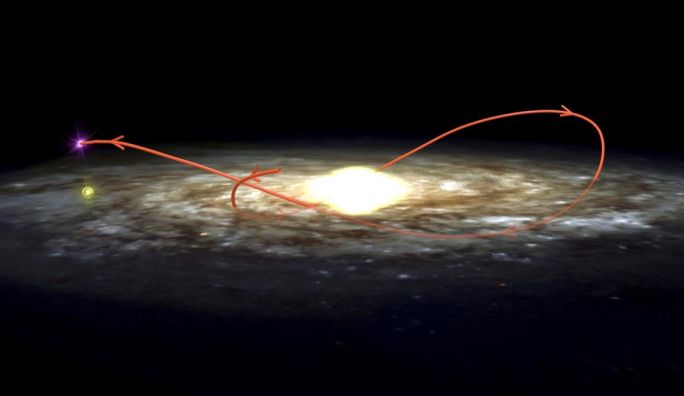Credit & Copyright: I. Rodrigues and
I. F. Mirabel
(IAFE,
SAp/CEA) et al.,
NRAO,
AUI,
NSF
(Orbit Illustration)
Explanation:
Black hole candidate XTE J1118+480 is known to roam the halo
of our Milky Way Galaxy.
This exotic
system - thought to be a
stellar mass black hole consuming
matter from a companion star - was discovered only last year as a
flaring celestial x-ray source.
Suggestively termed a
microquasar,
recent radio and archival optical observations of
its
motion through the sky have now allowed its
orbit to be calculated.
Illustrated above, the
black hole's present galactic location is
indicated by the purple dot, with the
Sun's position in yellow.
A mere 6,000 light-years from the Sun now, XTE J1118+480's orbit is
traced by the orange line, backtracked for some 230 million years into
the past based on models of the Galaxy.
Astronomers note this black hole's orbit about the galactic center,
looping high above and below
the Galaxy's
plane of gas, dust,and stars,
is similar to orbits of globular
star clusters,
ancient denizens of our Galaxy.
It seems likely that
XTE J1118+480 too has its origins in the early
history and
halo of the Milky Way.
(Orbit Illustration)
1999 2000 2001 2002 2003 2004 2005 2006 2007 2008 2009 2010 2011 2012 2013 2014 2015 2016 2017 2018 2019 2020 2021 2022 2023 2024 2025 |
Январь Февраль Март Апрель Май Июнь Июль Август Сентябрь Октябрь Ноябрь Декабрь |
NASA Web Site Statements, Warnings, and Disclaimers
NASA Official: Jay Norris. Specific rights apply.
A service of: LHEA at NASA / GSFC
& Michigan Tech. U.
|
Публикации с ключевыми словами:
черные дыры - black hole - XTE J1118+480 - Галактика - микроквазар - microquasar
Публикации со словами: черные дыры - black hole - XTE J1118+480 - Галактика - микроквазар - microquasar | |
См. также:
Все публикации на ту же тему >> | |
